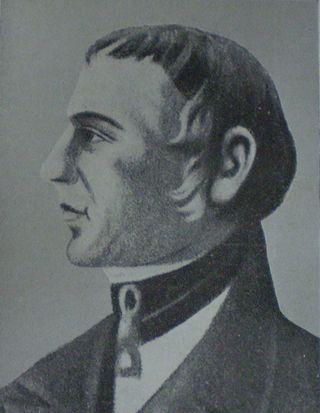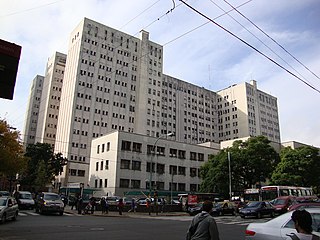
Bernardo Alberto Houssay was an Argentine physiologist. Houssay was a co-recipient of the 1947 Nobel Prize for Physiology or Medicine for discovering the role played by pituitary hormones in regulating the amount of glucose in animals, sharing the prize with Carl Ferdinand Cori and Gerty Cori. He is the first Latin American Nobel laureate in the sciences.

The Argentine War of Independence was a secessionist civil war fought from 1810 to 1818 by Argentine patriotic forces under Manuel Belgrano, Juan José Castelli, Martin Miguel de Guemes and José de San Martín against royalist forces loyal to the Spanish crown. On July 9, 1816, an assembly met in San Miguel de Tucumán, declaring independence with provisions for a national constitution.

The La Chacarita Cemetery is a cemetery located in the Chacarita neighborhood in Buenos Aires, Argentina. Occupying an area of 95 hectare, it is the largest in the country.

The Battle of Caseros was fought near the town of El Palomar, Argentina, on 3 February 1852, between forces of the Argentine Confederation, commanded by Juan Manuel de Rosas, and a coalition consisting of the Argentine provinces of Entre Ríos and Corrientes, the Empire of Brazil, and Uruguay.

Cosme Mariano Argerich was a pioneer of military medical practices in Argentina.
Campo de Mayo is a military base located in Greater Buenos Aires, Argentina, 30 km (19 mi) northwest of Buenos Aires.
The Arequito revolt, was a military revolt by officers of the Army of the North through which they recused themselves from the fight in the civil war against the federales. Their intention was to return to the front of the war against the royalists in Upper Peru, an objective that they could not ultimately meet. It signified the beginning of the disintegration of the Supreme Directorship and was one of the main causes of the centralist defeat at the Battle of Cepeda.

Manuel Nicolás Aristóbulo Savio was an Argentine engineer and military man, noted for his contribution to Argentine heavy industry in his roles as general manager of Fabricaciones Militares and SOMISA.

The Yellow fever in Buenos Aires was a series of epidemics that took place in 1852, 1858, 1870 and 1871, the latter being a disaster that killed about 8% of Porteños: in a city where the daily death rate was less than 20, there were days that killed more than 500 people. The Yellow Fever would have come from Asunción, Paraguay, brought by Argentine soldiers returning from the war just fought in that country, having previously spread in the city of Corrientes. As its worst, Buenos Aires population was reduced to a third because of the exodus of those escaping the scourge.
Manuel Gregorio Argerich or Manuel Argerich (1835–1871) was an Argentine philosopher, author, lawyer, politician, mathematician and medical doctor.

The Hospital de Clínicas "José de San Martín" is a teaching hospital located in Buenos Aires, Argentina. It belongs to the University of Buenos Aires (UBA) Faculty of Medical Sciences, currently the best ranked university in that country.

Argerich Hospital is a metropolitan public hospital in Buenos Aires, Argentina. The hospital is located in the La Boca neighborhood.

Claudio Mamerto Cuenca was an Argentine physician and poet.
Saturnino Canaveri was an Argentine military man and politician, who served as officer of the 2nd Cavalry Regiment. He took part in the main military actions that occurred during the Conquest of the Desert, including the actions prior to the Battle of Aluminé, against the Chilean Army.

Francisco Javier Muñiz was an Argentine colonel, legislator, and medical doctor. He treated patients and died during the Great Yellow Fever Epidemic of 1871. He was considered the first important naturalist from Argentina.

Tomás Onésimo Canavery (1839–1913) was an Argentine Catholic priest and military chaplain, who served under the command of Bartolomé Mitre during the War of the Triple Alliance. He participated in most of the military actions against the Paraguayan forces, being promoted to lieutenant colonel in the same battlefield by order of General Juan Andrés Gelly y Obes.

María Teresa Ferrari was an Argentine educator, physician, and women's rights activist. She was the first female university professor in Latin America and one of the first women allowed to teach medicine. She was a pioneering researcher in women's health, studying the use of radiation therapy rather than surgery for uterine tumors and developing a vaginoscope that revolutionized women's health care in Brazil. She established the first maternity ward and gynecological services at the Hospital Militar Central of Buenos Aires in 1925, which provided the first incubation services in the country.

Batallón de Voluntarios Rebajados de Buenos Aires was a 19th-century Argentine military unit formed mainly with veterans of the Brazilian War and the expeditionaries to the Desert of 1833 and 1834. It was a special unit of the Federal Party of active participation during the civil war between federales and unitarios.

The Faculty of Medical Sciences, formerly and commonly known as the Faculty of Medicine, is the medical school of the University of Buenos Aires (UBA), the largest university in Argentina. Established in 1822 as one of the UBA's earliest divisions, FMED is presently the largest medical school in Argentina, with over 24,000 enrolled students as of 2011.














